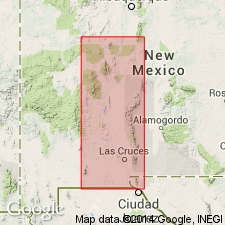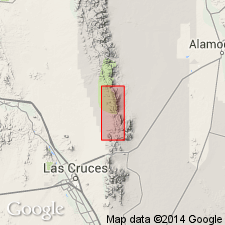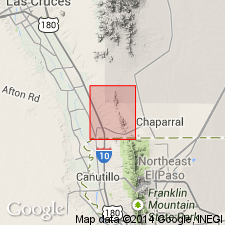
- Usage in publication:
-
- Panther Seep formation
- Modifications:
-
- Named
- Dominant lithology:
-
- Shale
- Siltstone
- Sandstone
- Gypsum
- Limestone
- AAPG geologic province:
-
- Orogrande basin
Summary:
Named. Type section measured in SE1/4 sec 14, T13S, R3E, Sierra Co, NM in the Orogrande basin. Is well exposed in Beardon, Rhodes, and Bosque Canyons. Named for Panther Seep in sec 25, T12S, R2E. Can be mapped from Mockingbird Gap to south end of San Andres Mountains and in northern Franklin Mountains. Thickens south from 200 ft in Oscura Mountains to 800 ft at Mockingbird Gap; 1,460 ft in Rhodes Canyon, 1,825 ft in Hembrillo Canyon; 2,400 ft in Ash Canyon. Remnants preserved in the Hueco Mountains. Consists of interbedded dark gray, blackish, reddish shale that may be sandy, silty, or calcareous; olive to brown calcareous siltstone; gray to brown, arkosic, calcareous sandstone; gray, silty, calcarenite to calcilutite; gray gypsum; gray silty to argillaceous limestone. Divisible into a lower and an upper member. Cross sections. Measured sections. Panther Seep at type: 1) unconformably overlies unnamed Missourian dark gray aphanitic limestone, and underlies basal limestone pebble conglomerate of Bursum formation; 2) is 1,458 ft of interbedded shale, limestone, sandstone. Patch reefs occur. Numerous fusulinids. Virgil age.
Source: GNU records (USGS DDS-6; Denver GNULEX).

- Usage in publication:
-
- Panther Seep Formation*
- Modifications:
-
- Revised
- Areal extent
- AAPG geologic province:
-
- Orogrande basin
Summary:
Revised in that unit conformably overlies newly named Lead Camp Limestone. Unit extended into southern San Andres Mountains, Dona Ana Co, NM, Orogrande basin. Thickness ranges from about 2370 ft at Lead Camp Canyon to about 2640 ft at Salt Canyon. Contains algae and some marine invertebrate fossils which are compatible with a Virgil (late Late Pennsylvanian) age; lower few hundred feet may be middle and late Missouri (early Late Pennsylvanian) age, and upper beds may be Wolfcamp age (early Early Permian). Probably deposited contemporaneously with arkosic limestone member of Madera Formation in central NM; correlates with Bar B Formation in Caballo Mountains to west and in part with Holder Formation in Sacramento Mountains to east. Geologic map.
Source: GNU records (USGS DDS-6; Denver GNULEX).

- Usage in publication:
-
- Panther Seep Formation
- Modifications:
-
- Areal extent
- Revised
- AAPG geologic province:
-
- Orogrande basin
Summary:
Extends unit to northern part of Franklin Mountains, southeast Dona Ana Co, NM, Orogrande basin. Exposed only in south-central part of mapped area at Dona Ana Co, NM-El Paso Co, TX border. Assigns to Magdalena Group as uppermost of four formations. Rocks assigned to Panther Seep designated by other workers as unnamed transitional member of Magdalena Formation. Conformably overlies Bishop Cap Formation of Magdalena; conformably underlies Hueco Limestone. Late Pennsylvanian (Virgilian) age; may be as old as Missourian and as young as Wolfcampian (Early Permian).
Source: GNU records (USGS DDS-6; Denver GNULEX).
For more information, please contact Nancy Stamm, Geologic Names Committee Secretary.
Asterisk (*) indicates published by U.S. Geological Survey authors.
"No current usage" (†) implies that a name has been abandoned or has fallen into disuse. Former usage and, if known, replacement name given in parentheses ( ).
Slash (/) indicates name conflicts with nomenclatural guidelines (CSN, 1933; ACSN, 1961, 1970; NACSN, 1983, 2005, 2021). May be explained within brackets ([ ]).

